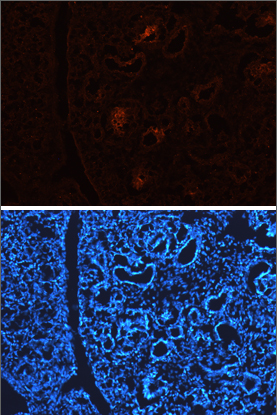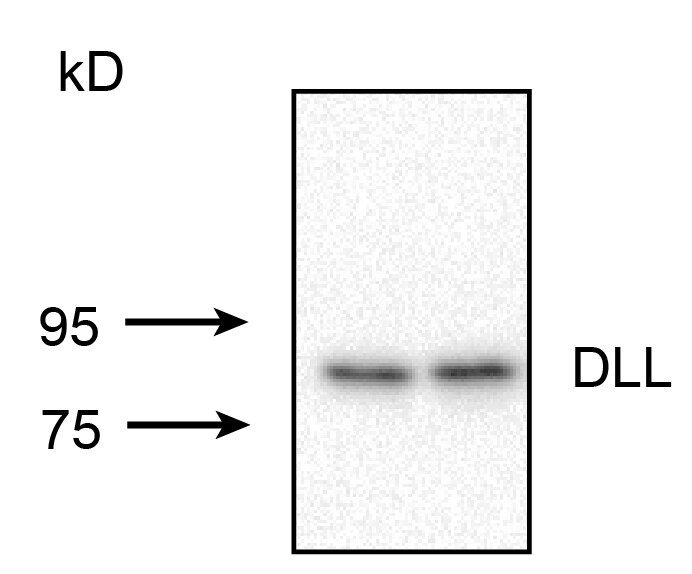Mouse/Rat DLL1 Antibody Summary
Ser22-Gln516
Accession # Q61483
Applications
Please Note: Optimal dilutions should be determined by each laboratory for each application. General Protocols are available in the Technical Information section on our website.
Scientific Data
 View Larger
View Larger
DLL1 in Embryonic Mouse Kidney. DLL1 was detected in immersion fixed frozen sections of embryonic mouse kidney (E13.5) using 10 µg/mL Sheep Anti-Mouse/Rat DLL1 Antigen Affinity-purified Polyclonal Antibody (Catalog # AF5026) overnight at 4 °C. Tissue was stained with the NorthernLights™ 557-conjugated Anti-Sheep IgG Secondary Antibody (red, upper panel; Catalog # NL010) and counterstained with DAPI (blue, lower panel). View our protocol for Fluorescent IHC Staining of Frozen Tissue Sections.
Reconstitution Calculator
Preparation and Storage
- 12 months from date of receipt, -20 to -70 °C as supplied.
- 1 month, 2 to 8 °C under sterile conditions after reconstitution.
- 6 months, -20 to -70 °C under sterile conditions after reconstitution.
Background: DLL1
Delta-like protein 1 (DLL1) is a 90‑100 kDa type I transmembrane protein in the Delta/Serrate/Lag-2 (DSL) family of Notch ligands. Mature mouse DLL1 consists of a 528 amino acid (aa) extracellular domain (ECD) with one DSL domain and eight EGF-like repeats, a 23 aa transmembrane segment, and a 154 aa cytoplasmic domain (1). Within the ECD, mouse DLL1 shares 91% and 95% aa sequence identity with human and rat DLL1, respectively. It shares 26%, 35%, and 51% aa sequence identity with DLL2, 3, and 4, respectively. A 60 kDa ECD fragment, released by ADAM9, 12, or 17 mediated proteolysis, promotes the proliferation of hematopoietic progenitor cells (2, 3). The residual membrane-bound portion of DLL1 can be cleaved by presenilin-dependent gamma -secretase, enabling the cytoplasmic domain to migrate to the nucleus (4). DLL1 localizes to adherens junctions on neuronal processes through its association with the scaffolding protein MAGI1 (5). DLL1 is widely expressed, and it plays an important role in embryonic somite formation, cochlear hair cell differentiation, lymphocyte differentiation, and the maintenance of neural and myogenic progenitor cells (6‑12). The upregulation of DLL1 in arterial endothelial cells following injury or angiogenic stimulation is central to postnatal arteriogenesis (13). DLL1 is also overexpressed in cervical carcinoma and glioma and contributes to tumor progression (14‑15).
- Bettenhausen, B. et al. (1995) Development 121:2407.
- Dyczynska, E. et al. (2007) J. Biol. Chem. 282:436.
- Karanu, F.N. et al. (2001) Blood 97:1960.
- Ikeuchi, T. and S.S. Sisodia (2003) J. Biol. Chem. 278:7751.
- Mizuhara, E. et al. (2005) J. Biol. Chem. 280:26499.
- Takahashi, Y. et al. (2003) Development 130:4259.
- Teppner, I. et al. (2007) BMC Dev. Biol. 7:68.
- Kiernan, A.E. et al. (2005) Development 132:4353.
- Schmitt, T.M. and J.C. Zuniga-Pflucker (2002) Immunity 17:749.
- Hozumi, K. et al. (2004) Nat. Immunol. 5:638.
- Shimojo, H. et al. (2008) Neuron 58:52.
- Schuster-Gossler, K. et al. (2007) Proc. Natl. Acad. Sci. 104:537.
- Limbourg, A. et al. (2007) Circ. Res. 100:363.
- Purow, B.W. et al. (2005) Cancer Res. 65:2353.
- Gray, G.E. et al. (1999) Am. J. Pathol. 154:785.
Product Datasheets
Citations for Mouse/Rat DLL1 Antibody
R&D Systems personnel manually curate a database that contains references using R&D Systems products. The data collected includes not only links to publications in PubMed, but also provides information about sample types, species, and experimental conditions.
5
Citations: Showing 1 - 5
Filter your results:
Filter by:
-
Temperature sensitivity of Notch signaling underlies species-specific developmental plasticity and robustness in amniote brains
Authors: T Nomura, K Nagao, R Shirai, H Gotoh, M Umeda, K Ono
Nature Communications, 2022-01-10;13(1):96.
Species: Chicken
Sample Types: Cell Lysates
Applications: Western Blot -
Notch signaling is a critical initiator of roof plate formation as revealed by the use of RNA profiling of the dorsal neural tube
Authors: S Ofek, S Wiszniak, S Kagan, M Tondl, Q Schwarz, C Kalcheim
Bmc Biology, 2021-04-23;19(1):84.
Species: Mouse
Sample Types: Embryo
Applications: IHC -
Notch signalling defines dorsal root ganglia neuroglial fate choice during early neural crest cell migration
Authors: S Wiszniak, Q Schwarz
BMC Neurosci, 2019-04-29;20(1):21.
Species: Mouse
Sample Types: Whole Tissue
Applications: IHC-F -
Dll1 Marks Cells of Origin of Ras-Induced Cancer in Mouse Squamous Epithelia
Authors: E Vasilaki, Z Kanaki, DJ Stravopodi, A Klinakis
Transl Oncol, 2018-08-03;11(5):1213-1219.
Species: Mouse
Sample Types: Whole Tissue
Applications: IHC-Fr -
Data showing proliferation and differentiation of intestinal epithelial cells under targeted depletion of Notch ligands in mouse intestine.
Authors: Toru Nakata, Hiromichi Shimizu, Sayaka Nagata, Go Ito, Satoru Fujii, Kohei Suzuki, Ami Kawamoto, Fumiaki Ishibashi, Reiko Kuno, Sho Anzai, Tatsuro Murano, Tomohiro Mizutani, Shigeru Oshima, Kiichiro Tsuchiya, Tetsuya Nakamura, Katsuto Hozumi, Mamoru Watanabe, Ryuichi Okamoto
Data in Brief, 2016-12-29;0(0):2352-3409.
Species: Mouse
Sample Types: Whole Tissue
Applications: IHC
FAQs
No product specific FAQs exist for this product, however you may
View all Antibody FAQsReviews for Mouse/Rat DLL1 Antibody
Average Rating: 5 (Based on 1 Review)
Have you used Mouse/Rat DLL1 Antibody?
Submit a review and receive an Amazon gift card.
$25/€18/£15/$25CAN/¥75 Yuan/¥2500 Yen for a review with an image
$10/€7/£6/$10 CAD/¥70 Yuan/¥1110 Yen for a review without an image
Filter by:



